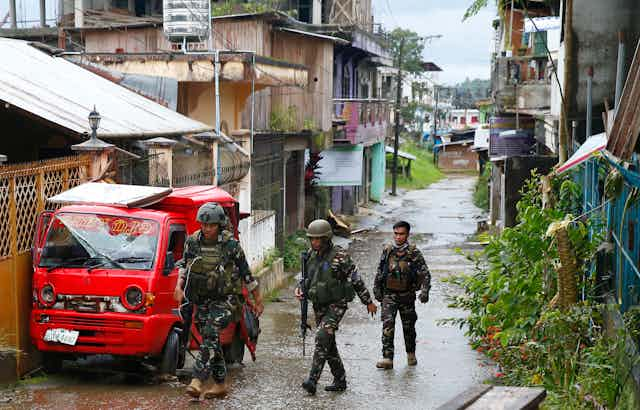For almost five months, 21 million people in the southern Philippines have been living under martial law.
Philippine President Rodrigo Duterte declared martial law in the province of Mindanao in May in response to increasing Islamist militant activity.
Since that time, more than 1,000 people, mostly militants, have died in the army’s campaign to clear Marawi city of Islamist insurgents. Though the leaders of two groups were recently killed by the army and Duterte declared Marawi “liberated,” sporadic fighting continues. Duterte himself recently stated that martial law will remain “until the last terrorist is taken out.”
Such statements have led many – and not just human rights scholars like myself – to wonder, when will full democracy be restored in the Philippines?
Undermining democracy
States of emergency, of which martial law is an extreme form, allow governments facing serious crises to suspend certain laws and enact emergency plans. For example, under martial law the government can impose a curfew or suspend habeas corpus, allowing individuals to be arrested and detained without warrants. Martial law is permitted in the Constitution of the Philippines and the International Covenant on Civil and Political Rights. This is also true in the United States. During the American Civil War, Congress authorized the suspension of habeas corpus in 1863 at President Lincoln’s request. But, martial law increases risks of human rights abuses.

This is not the Philippines’ first experience with martial law. When President Ferdinand Marcos declared martial law in 1972, he emphasized that it did not represent a military takeover but rather a response to a foreign-directed attempt to overthrow the government. But, he ultimately used martial law as a pretext to install a dictatorship that lasted until 1986. Under his regime, 70,000 Filipinos were imprisoned and 34,000 were tortured, according to Amnesty International.
Duterte, who is known for his increasingly unpopular “war on drugs” and links to death squads responsible for extrajudicial killings while he was mayor of Davao City, hinted as early as August 2016 that he might use martial law to circumvent constitutional limits on his power.
And once Duterte eventually declared martial law, the military immediately announced that it would censor the press and social media so that military operations would not be compromised.
The president himself has repeatedly said that he will consider expanding martial law to cover the entire country and praised Marcos’s use of martial law. More recently, Duterte said that he will use force in response to anti-government protests that threaten public order.
Political rights, like the freedom to peacefully assemble, are essential to the public’s ability to check executive power. When political rights are compromised, as with the censorship of the press and social media or the suppression of protests, the foundation of democracy can rapidly erode – as citizens of Venezuela and Turkey have recently experienced.
Will martial law continue?
Martial law continues even as civilians are being urged to return to their homes.
When martial law will be lifted remains uncertain. On July 22, 2017, the Philippine Congress voted to extend martial law until December 2017. Any decision to lift it early will have to come from the president. This opens the door for Duterte to find justifications for continuing and possibly extending martial law beyond December.
Prominent opposition leaders like Sen. Risa Hontiveros-Baraquel have referred to Duterte’s rule as a “Dutertatorship,” and accused his regime of showing a blatant disregard for democracy. But the Senate has so far given a stamp of approval for Duterte’s plans. This political support would give him even greater power if he attempts to extend or expand martial law. However, that’s not a foregone conclusion.
Duterte did little to oppose legal objections to martial law, which made their way to the Supreme Court. Although he has targeted individual opponents, like Sen. Leila De Lima, Duterte is not simply shutting down his opposition. For example, he spoke to thousands of protesters outside of his July 2017 State of the Nation address and allowed protests on the 45th anniversary of the imposition of martial law by Marcos. These are promising signs.
Filipinos have been reenergized, staging protests against a range of issues including police brutality and large-scale mining. Critics have challenged Duterte’s 2016 burial of Marcos in the country’s cemetery for national heroes and raised alarms about his coziness with the Marcos clan. If martial law is lifted early or allowed to expire in December, then Duterte’s experiment with martial law may have in fact been good for democracy in the Philippines. Only time will tell.

